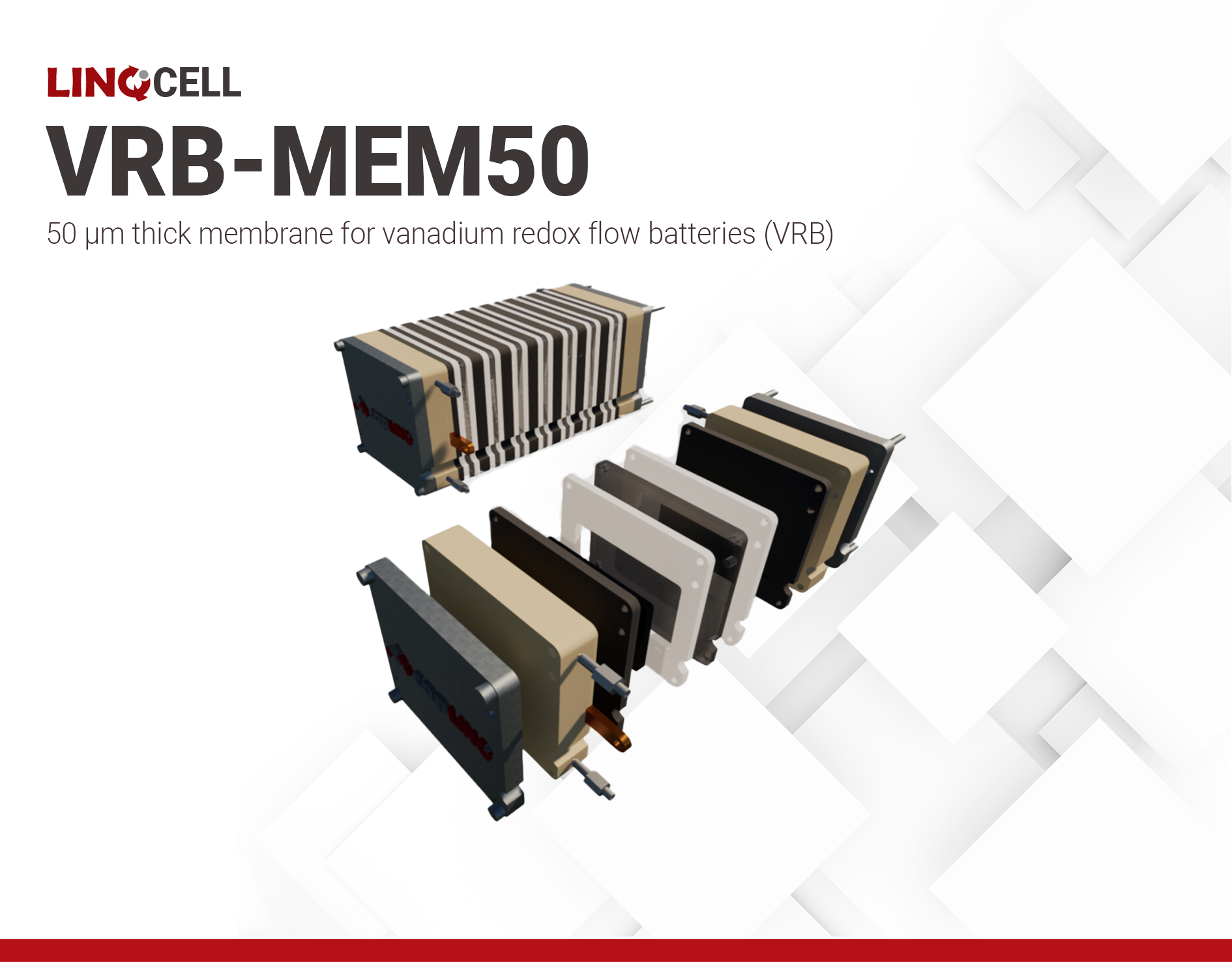VRB-MEM50 | 50μm VRB membrane
- Designed as cation (proton) exchange membranes for redox flow batteries
- High acid capacity and conductivity for improved performance
- Extended service life
Product Description
LINQCELL VRB-MEM50 is a 50 µm-thick perfluorinated cation exchange membrane produced through solution casting. This chemistry and manufacturing method provide several benefits, including high acid capacity and conductivity, enhanced crystallinity and tensile strength, reduced linear expansion and anisotropy, and an extended service life. These characteristics make LINQCELL VRB-MEM75 highly recommended for use as ion exchange membranes in redox flow batteries, particularly in all-vanadium flow batteries.
Key Features:
- High Ionic Conductivity and Acid Capacity: High ionic conductivity and acid capacity enable efficient ion transport within the flow battery stack, supporting optimal electrochemical performance. When used in vanadium redox flow battery stacks, the Coulombic efficiency was as high as 96%. This value is not standard and will vary depending on the battery design, including factors such as electrode thickness and electrolyte concentration.
- Good Mechanical and Hydrolytic Properties: High tensile strength, low anisotropy, and minimal linear expansion upon conditioning ensure the membrane remains stable and durable under operational conditions.
- Long Service Life: With a service life >100,000 hours, LINQCELL VRB-MEM75 offers exceptional durability, reducing maintenance and replacement costs while improving reliability for continuous operation.
Highly Recommended As:
- Ion exchange membranes of redox flow batteries
LINQCELL VRB-MEM50 is part of the LINQCELL VRB-MEM Membrane Series, which offers two standard thicknesses: 50 µm (VRB-MEM50) and 75 µm (VRB-MEM75). These membranes can also be custom-fabricated to meet specific requirements, with a maximum roll width of 75 cm. Both VRB-MEM50 and VRB-MEM75 are supplied in the dry, acid (H+) form.
Technical Specifications
| Hydrolytic Properties | |||||
| Water Uptake | 49 % | ||||
| General Properties | |||||
| Specific Gravity Specific Gravity Specific gravity (SG) is the ratio of the density of a substance to the density of a reference substance; equivalently, it is the ratio of the mass of a substance to the mass of a reference substance for the same given volume. For liquids, the reference substance is almost always water (1), while for gases, it is air (1.18) at room temperature. Specific gravity is unitless. | 2 | ||||
| Total Thickness Total Thickness Total thickness is taking into account all the films, coatings, adhesives, release liners and special layers and is the maximum thickness of a film or tape. | 73–77 μm | ||||
| Physical Properties | |||||
| Young's modulus | 600 MPa | ||||
| Mechanical Properties | |||||
| Elongation Elongation Elongation is the process of lengthening something. It is a percentage that measures the initial, unstressed, length compared to the length of the material right before it breaks. It is commonly referred to as Ultimate Elongation or Tensile Elongation at break. | >160 % | ||||
| |||||
Additional Information
Properties and Performance of LINQCELL VRB-MEM Series in Vanadium Redox Flow Batteries
| Property | VRB-MEM50 | VRB-MEM75 | Unit |
| Physical Properties | |||
| Thickness | 50 (±2) | 75 (±2) | µm |
| Specific Gravity | 2 | – | |
| Tensile Strength (MD/TD) | 38/38 | MPa | |
| Modulus | 600 | MPa | |
| Elongation to Break | 160 | % | |
| Hydrolytic Properties | |||
| Water Content1 | 5 | % | |
| Water Uptake2 | 49 | % | |
Linear Expansion from 23 °C, 50% RH to water soaked, 23 °C to water soaked, 100 °C |
3 5 | % | |
| Other Properties | |||
| Available Acid Capacity | 1 | meq/g | |
| Conductivity | 0.1 | S/cm | |
| Hydrogen Permeability | 0.008 | N/A | mL/(min⋅cm) |
| Performance in Vanadium Redox Flow Batteries | |||
| Voltage Efficiency | 90 | 90 | % |
| Energy Efficiency | 86 | 87 | % |
| Coulombic Efficiency | 95.6 | 96.7 | % |
1Water content of the membrane conditioned at 23 °C and 50% relative humidity, based on dry weight.
2Water absorption from a dry membrane to a conditioned state in water at 100 °C for 1 hour, based on dry weight.



